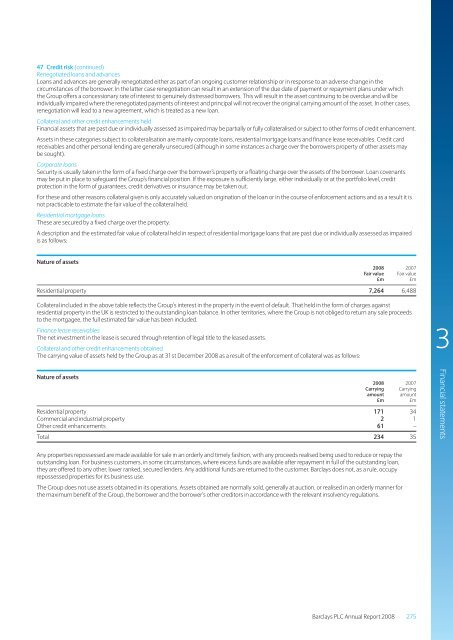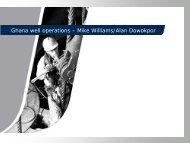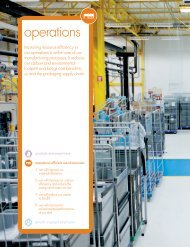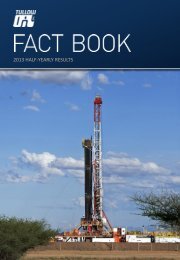Barclays plc - Annual Report 2008 - Financial statements - The Group
Barclays plc - Annual Report 2008 - Financial statements - The Group
Barclays plc - Annual Report 2008 - Financial statements - The Group
You also want an ePaper? Increase the reach of your titles
YUMPU automatically turns print PDFs into web optimized ePapers that Google loves.
47 Credit risk (continued)<br />
Renegotiated loans and advances<br />
Loans and advances are generally renegotiated either as part of an ongoing customer relationship or in response to an adverse change in the<br />
circumstances of the borrower. In the latter case renegotiation can result in an extension of the due date of payment or repayment plans under which<br />
the <strong>Group</strong> offers a concessionary rate of interest to genuinely distressed borrowers. This will result in the asset continuing to be overdue and will be<br />
individually impaired where the renegotiated payments of interest and principal will not recover the original carrying amount of the asset. In other cases,<br />
renegotiation will lead to a new agreement, which is treated as a new loan.<br />
Collateral and other credit enhancements held<br />
<strong>Financial</strong> assets that are past due or individually assessed as impaired may be partially or fully collateralised or subject to other forms of credit enhancement.<br />
Assets in these categories subject to collateralisation are mainly corporate loans, residential mortgage loans and finance lease receivables. Credit card<br />
receivables and other personal lending are generally unsecured (although in some instances a charge over the borrowers property of other assets may<br />
be sought).<br />
Corporate loans<br />
Security is usually taken in the form of a fixed charge over the borrower’s property or a floating charge over the assets of the borrower. Loan covenants<br />
may be put in place to safeguard the <strong>Group</strong>’s financial position. If the exposure is sufficiently large, either individually or at the portfolio level, credit<br />
protection in the form of guarantees, credit derivatives or insurance may be taken out.<br />
For these and other reasons collateral given is only accurately valued on origination of the loan or in the course of enforcement actions and as a result it is<br />
not practicable to estimate the fair value of the collateral held.<br />
Residential mortgage loans<br />
<strong>The</strong>se are secured by a fixed charge over the property.<br />
A description and the estimated fair value of collateral held in respect of residential mortgage loans that are past due or individually assessed as impaired<br />
is as follows:<br />
Nature of assets<br />
<strong>2008</strong> 2007<br />
Fair value Fair value<br />
£m £m<br />
Residential property 7,264 6,488<br />
Collateral included in the above table reflects the <strong>Group</strong>’s interest in the property in the event of default. That held in the form of charges against<br />
residential property in the UK is restricted to the outstanding loan balance. In other territories, where the <strong>Group</strong> is not obliged to return any sale proceeds<br />
to the mortgagee, the full estimated fair value has been included.<br />
Finance lease receivables<br />
<strong>The</strong> net investment in the lease is secured through retention of legal title to the leased assets.<br />
Collateral and other credit enhancements obtained<br />
<strong>The</strong> carrying value of assets held by the <strong>Group</strong> as at 31st December <strong>2008</strong> as a result of the enforcement of collateral was as follows:<br />
3<br />
Nature of assets<br />
<strong>2008</strong> 2007<br />
Carrying Carrying<br />
amount amount<br />
£m £m<br />
Residential property 171 34<br />
Commercial and industrial property 2 1<br />
Other credit enhancements 61 –<br />
Total 234 35<br />
<strong>Financial</strong> <strong>statements</strong><br />
Any properties repossessed are made available for sale in an orderly and timely fashion, with any proceeds realised being used to reduce or repay the<br />
outstanding loan. For business customers, in some circumstances, where excess funds are available after repayment in full of the outstanding loan,<br />
they are offered to any other, lower ranked, secured lenders. Any additional funds are returned to the customer. <strong>Barclays</strong> does not, as a rule, occupy<br />
repossessed properties for its business use.<br />
<strong>The</strong> <strong>Group</strong> does not use assets obtained in its operations. Assets obtained are normally sold, generally at auction, or realised in an orderly manner for<br />
the maximum benefit of the <strong>Group</strong>, the borrower and the borrower’s other creditors in accordance with the relevant insolvency regulations.<br />
<strong>Barclays</strong> PLC <strong>Annual</strong> <strong>Report</strong> <strong>2008</strong> 275

















